Dragonflies and Damselflies Life Cycle
- Dragonflies adults are colourful and eyes catching but their larvae are less familiar to us. The grow of dragonflies can hardly be classified in to in-complete metamorphosis nor complete metamorphosis. Metamorphosis in Dragonflies and Damselflies is quite different form other insects. Their larvae look very different from adults but they do not have pupa stage.
-

- Dragonflies have three development stages, eggs, larva and adult. Females lay eggs in flash water. Larva live in water, grow with a few times of molting. In the final stage the larva comes out of water and turns into adult.
- Dragonfly and damselfly larvae need fairly precise habitat and sensitive to water quality. Some species prefer still waters such as lagoon and ponds. Others prefer running waters such as creeks and streams. Females lay eggs in water. Some species insert eggs in plants while other just drop onto water. Some lay eggs in wet soil and some lay eggs in tree holes with water.
-


- Female laying eggs Dragonfly eggs in a fish-tank
- Dragonfly and damselfly eggs are elongate, oval to round in shapes, with creamy white in colour. Eggs may or may not hatch immediately, depends on species. Some species may wait for the season and survive the winter in the egg stage.
Eggs
Larvae
Dragonfly and damselfly larva live in water, grow with a few times (9-15) of moulting.
- Damselfly larvae use its caudal gills (the three tails) to breath in water. Comparing with dragonfly larvae they are slender.
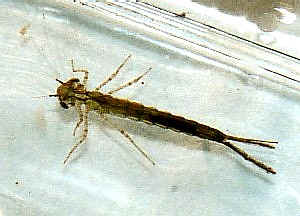
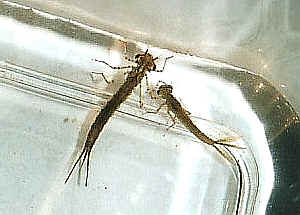
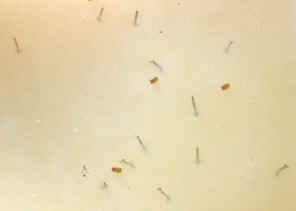
- Damselfly larvae 20mm



- Dragonfly larva
- Dragonfly larvae breathe by internal tracheal gills and do not have external "tails". They are stouter. They can propel themselves by forcing water out of the anus under pressure.
- The larvae are predator in water preying on small animals such as mosquitoes larva. They capture prey by thrusting out the large extendable jaw.

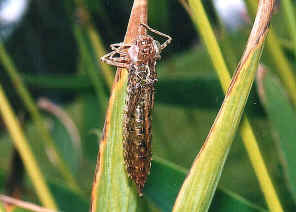
- 30mm and 40mm
- Just before the last molting, the larva climb up from the water and emerge from the last molting skin. Near the creeks and ponds we usually found those exuviae, the moulting skin left after the larva climbed up from the water and emerged as an adults. Larvae may spend one to three years in water, depend on species, while adults live only one to three months.

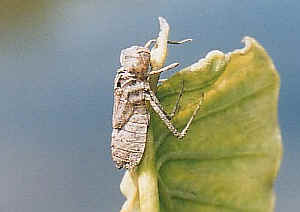
- We found this moulting skin (1st picture) on a broken tree trunk which is about 2 meters from the water edge.
- When the larva is fully developed, it moves to the exposed rock or plants where it prepares for the final stage of metamorphosis. The adult comes out from the split of the larval skin at the thorax. The emergence may take about one hour. Most species emerge during the night to early in the morning.

- The above picture was taken early in the morning, the Australian Emerald Dragonfly nymph came out from water, just emerged and becoming an adult.


- First picture shows a newly emerged Blue Riverdamsel, its body is soft and the body colour is not normal yet. The second picture shows a Eastern Dart damselfly had just emerged from last moulting. It was pale green in colour, its body was weak and could not fly properly. their body would be harden and turn into adult colours within hours. Before this, the young damselfly was quite vulnerable. The pale green colour helped it hiding among plants during this dangerous period.
- Maturation of most adults dragonflies takes up to two weeks or less. During this period the colours of the dragonflies, especially the male, can change dramatically. For those immature adults, they usually hunt in bush far away from the waters. They will return to the waters when matured, some will even return to their place of emergence.
- Following is an example of maturation of the male Blue Skimmer. Although this species is common, sometimes we found confusing in recognizing this dragonfly. The males keep changing colours when from just emerged to matured.

- Teneral male
- The males just emerged, or the teneral males, have the yellow body with dull black patterns.


- Maturing male with colour changing
- Its body will turn to light powder blue when maturing. Usually they are found hunting over the bush a few hundred meters away from the waters.


- Matured male
- Matured males have the powder blue body colour. They are found resting or flying amount the low vegetations over the pond.


- Old male
- Its broken wings show that it had been fighting with other males many times.
- Reproduction in dragonflies is most unusual and its evolution is a puzzle. We discussed the dragonflies reproduction in this page.
- Reference:
- 1. Insects of Australia - CSIRO, Division of Entomology, Melbourne University Press, 2nd Edition 1991, p294.
- 2. Insects of Australia and New Zealand - R. J. Tillyard, Angus & Robertson, Ltd, Sydney, 1926, p65.
- 3. The Australian Dragonflies - CSIRO, Watson, Theisinger & Abbey,1991.
- 4. A Field Guide to Dragonflies of South East Queensland - Ric Nattrass, 2006.
- 5. The Complete Field Guide to Dragonflies of Australia - CSIRO, GŁnther Theischinger and John Hawking, 2006.
- 6. Field Guide to Dragonflies of Hong Kong - Keith DP Wilson, Cosmos Books, 2003, p20.
Back to Top
